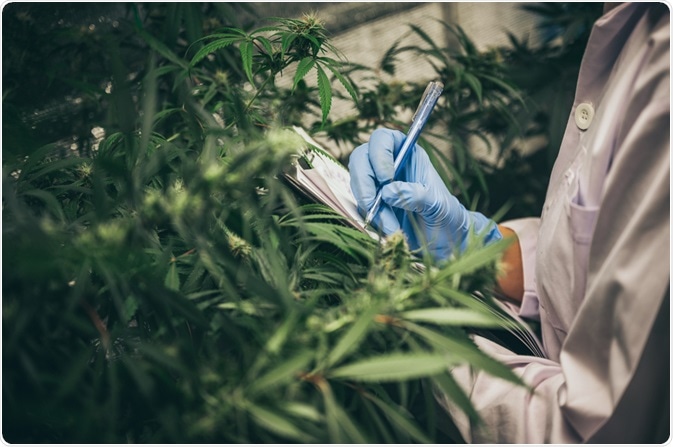Marijuana is a psychoactive drug from the cannabis plant and is native to Central Asia and India. It has been used in medicines and for recreational use for thousands of years. The active ingredient that is associated with the psychoactive component of cannabis is tetrahydrocannabinol (THC). However, there are over 400 known compounds found in the plant.

Image Credit: Chokniti Khongchum/Shutterstock.com
Cannabis is typically used for recreational or medicinal purposes. The medical uses for cannabis are for treatment in patients undergoing chemotherapy, to reduce nausea and vomiting. It has also been used to improve appetite in people with HIV/AIDS, as well as treat patients with chronic pain. The most common ways to ingest cannabis for its active ingredient is by smoking, vaporizing, eating, or extracting the oil or resin.
Additionally, some common effects from cannabis include increased heart rate, euphoria, short-term memory loss, dry mouth (cottonmouth), red eyes, and an increased appetite. The effects typically occur within minutes of smoking but can take up to an hour when eaten, lasting up to six hours. Cannabis is the most commonly used illegal drug in the world but is gaining traction for legalization in several countries.
Cannabis Production
Greenhouse gases (GHG) are gaseous molecules that absorb and emit radiation within the mid-infrared range of the electromagnetic spectrum causing global warming. A carbon footprint is the total amount of GHG emissions produced. The primary greenhouse gases of concern in the atmosphere when trying to calculate the carbon footprint are carbon dioxide (CO2) and methane (CH4).
Once a carbon footprint can be calculated, it is then easier to devise a plan to reduce the overall emissions. Since the industrial revolution in the mid-18th century, it has been calculated that the increase in carbon dioxide has almost doubled.
The production of cannabis, especially indoor production, is an extremely energy-intensive process to ensure the correct conditions are maintained for optimal results and yields. Within the United States alone, about $6 billion each year is spent on cannabis production, which equates to about 1% of electricity use nationally. Furthermore, there are also industrial uses for cannabis production. This is centered around the production of hemp because it can be used for the production of fibers and several commercial products such as paper, clothing, and textiles. It is also found in biofuels and food products.
The current practice of indoor cultivation of cannabis is largely driven by criminalization and the processes needed in production to maintain high-quality yields. However, if the production of cannabis became legalized, then it is likely to lower the prices of the product and would make the production of cannabis too expensive to be lucrative for criminal organizations. Although the legalization of cannabis has caused a significant increase in commercial production, especially indoors for security and quality control, the environmental impact has not been assessed or quantified.
Carbon Footprint of Cannabis Production
Industry practice for calculating the carbon footprint of a person, service, or industry is by using life-cycle assessment (LCA). This is a methodology for assessing environmental impacts associated with all the stages of a life cycle or process, but must be followed by strict ISO standards for reproducibility.
Approximately 2.2 – 5.2 tonnes of carbon dioxide is released per kilogram of cannabis produced indoors. This is largely due to electricity production and natural gas consumption from controlling temperature and lighting in the process.
Additionally, carbon emissions have been associated with compressing and shipping cannabis, which accounts for about 0.5 tonnes of emissions for every kilogram of cannabis produced. It is difficult to account for all GHG emissions when calculating a carbon footprint, so analysis of carbon dioxide emission is the common component analyzed.
Outdoor production of cannabis that has natural light sources is an obvious solution to indoor cultivation if trying to reduce the carbon footprint. This is largely because there is less need for lights and temperature controls that would otherwise be needed for indoor production. It is estimated that switching to an outdoor production of cannabis, would reduce the carbon footprint by 96%.
However, it would be difficult to calculate the GHG emissions associated with outdoor growth methods. This is because for the outdoor cultivation of cannabis it would require considerations around pesticide production, irrigation, and possibly deforestation. Thus, establishing best practices for outdoor cannabis production while reducing the carbon footprint would be difficult.
Sources:
- Vij (2012). Textbook Of Forensic Medicine And Toxicology: Principles And Practice. Elsevier India. p. 672.
- Russo EB (2013). Cannabis and Cannabinoids: Pharmacology, Toxicology, and Therapeutic Potential. Routledge. p. 28.
- Osborne GB, Fogel C (2008). "Understanding the motivations for recreational marijuana use among adult Canadians". Substance Use & Misuse. 43 (3–4): 539–72, discussion 573–9, 585–7
- Mills E (2012). “The carbon footprint of indoor Cannabis production”. Energy Policy. 46, 58-67.
- Borgelt LM, Franson KL, Nussbaum AM, Wang GS (February 2013). "The pharmacologic and clinical effects of medical cannabis". Pharmacotherapy (Review). 33 (2): 195–209.
- Whiting PF, Wolff RF, Deshpande S, Di Nisio M, Duffy S, Hernandez AV, et al. (23 June 2015). "Cannabinoids for Medical Use: A Systematic Review and Meta-analysis". JAMA. 313 (24): 2456–73.
Further Reading